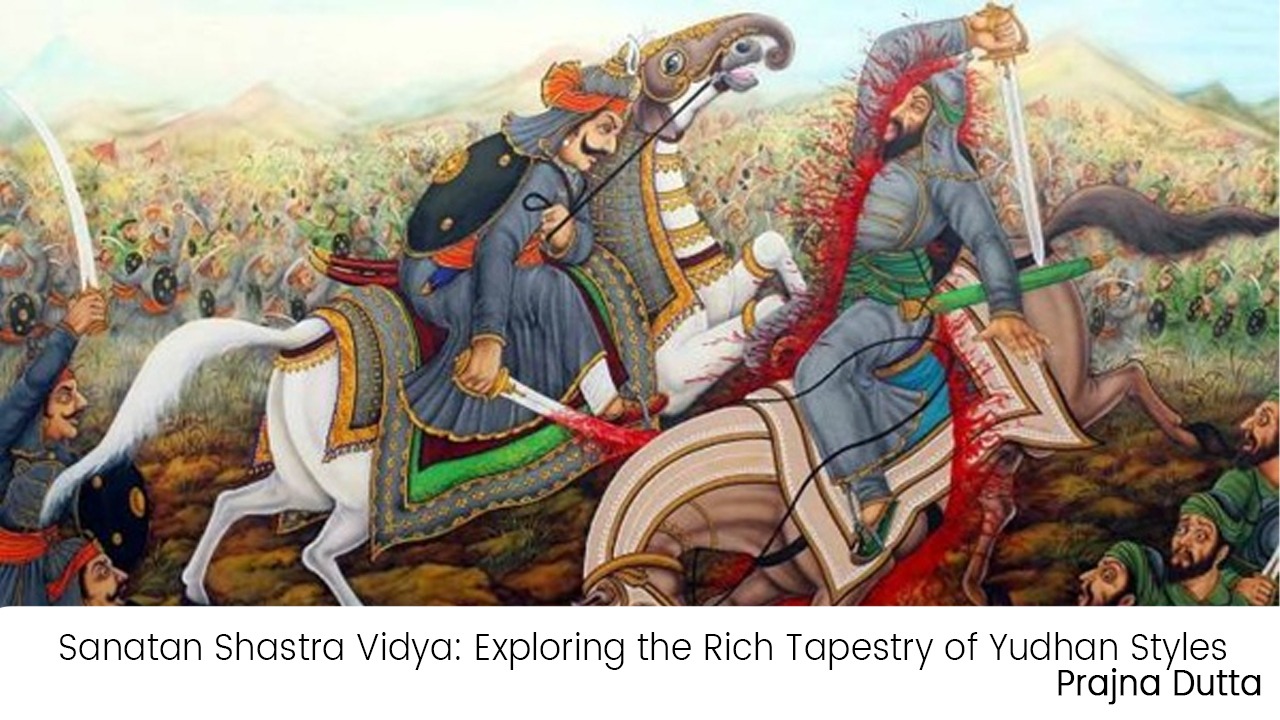Introduction:
Sanatan Shastra Vidya, the ancient science of combat, encompasses a vast array of yudhān styles that hold deep cultural and historical significance in India. Rooted in ancient scriptures and martial traditions, these styles offer unique insights into the diverse strategies and techniques employed in battle. In this article, we delve into the essence of Sanatan Shastra Vidya and explore additional fascinating styles of yudhān.
1. Chandi: The Fierce Warrior Style:
Chandi, derived from the divine form of Goddess Chandi, embodies the fierce and intense aspect of combat. This style focuses on relentless offense, speed, and agility. Chandi practitioners are known for their lightning-fast strikes, acrobatic movements, and unwavering pursuit of victory. Combining footwork, hand strikes, kicks, and grappling techniques, Chandi overwhelms opponents with its ferocity.
2. Varaha: The Boar Style:
Named after Lord Varaha, the boar incarnation of Lord Vishnu, the Varaha style emphasizes strength, stability, and resilience. This style combines robust defense techniques with powerful strikes. Varaha practitioners endure attacks, maintain a firm stance, and launch precise counter-attacks. Characterized by low stances, circular movements, and sweeping strikes, Varaha style aims to overpower opponents with its unwavering strength.
3. Ganesh: The Remover of Obstacles Style:
Inspired by Lord Ganesh, the remover of obstacles, this style focuses on adaptability, intelligence, and strategy. Ganesh practitioners employ a combination of defensive techniques, evasive footwork, and skillful use of weapons. They analyze opponents' strengths and weaknesses, seeking to exploit vulnerabilities with calculated precision. Mental agility, quick thinking, and the ability to adjust tactics in real-time are the hallmarks of the Ganesh style.
4. Hanuman: The Monkey God Style:
Based on the divine form of Lord Hanuman, the monkey god, this style emphasizes agility, flexibility, and versatility. Hanuman practitioners showcase swift movements, acrobatic maneuvers, and mastery of close-quarters combat. With exceptional reflexes and dexterity, they evade attacks while delivering lightning-fast strikes. Incorporating jumps, rolls, and kicks, the Hanuman style disorients and overpowers opponents with its dynamic and nimble approach.
5. Dhanurveda: The Science of Archery:
Apart from the aforementioned styles, Sanatan Shastra Vidya encompasses Dhanurveda, the ancient science of archery. This style focuses on mastering the bow and arrow, including techniques for long-range combat, accuracy, and precision. Dhanurveda practitioners develop exceptional hand-eye coordination, refined aiming skills, and mastery of different types of bows and arrows. The skillful use of Dhanurveda plays a vital role in both battlefield scenarios and hunting.
6. Bhima: The Mighty Warrior Style:
Drawing inspiration from the formidable warrior Bhima of the Mahabharata, this style emphasizes brute strength, raw power, and devastating strikes. Bhima practitioners hone their physical prowess, delivering bone-crushing blows, and overpowering opponents with sheer force. This style incorporates powerful grappling techniques, throws, and strikes that showcase the warrior's indomitable spirit and unmatched might.
7. Krishna: The Enlightened Warrior Style:
Inspired by Lord Krishna,the enlightened warrior, this style of yudhān focuses on a harmonious integration of physical skill, mental acuity, and spiritual awareness. Krishna practitioners embody grace, precision, and strategic thinking. They employ fluid movements, utilizing leverage and timing to subdue opponents. The Krishna style emphasizes the understanding of one's own inner self, the ability to perceive the intentions of others, and the application of wisdom in combat.
8. Rama: The Ideal King Style:
Derived from the valiant King Rama of the epic Ramayana, this style embodies leadership, valor, and righteousness. Rama practitioners exhibit a balanced approach, combining offensive and defensive maneuvers. They prioritize discipline, honor, and adherence to a code of conduct. The Rama style emphasizes the use of weapons such as the bow and arrow, sword, and mace, displaying the virtues of a just ruler and a skilled warrior.
9. Shiva: The Destroyer Style:
Inspired by Lord Shiva, the destroyer and transformer, this style focuses on unconventional and unpredictable combat techniques. Shiva practitioners embody controlled aggression, utilizing dynamic movements, devastating strikes, and unorthodox methods. They harness their inner power and tap into the cosmic energy to overwhelm opponents. The Shiva style blends physical prowess with spiritual awareness and the ability to adapt to any situation.
10. Kali: The Fierce Goddess Style:
Derived from the divine form of Goddess Kali, this style represents ferocity, fearlessness, and transformative energy. Kali practitioners exhibit intense aggression, rapid strikes, and fearless engagement. They channel the primal energy within, unleashing a devastating assault on opponents. The Kali style incorporates both armed and unarmed combat, emphasizing speed, precision, and the ability to strike at the most vulnerable points.
Conclusion:
Sanatan Shastra Vidya encompasses a rich tapestry of yudhān styles that reflect the diverse aspects of combat and warriorhood. From the fierce intensity of Chandi to the adaptability of Ganesh, the strength of Varaha, and the agility of Hanuman, each style brings a unique approach to the art of combat. Integrated with archery in Dhanurveda and further expanded with the Bhima, Krishna, Rama, Shiva, and Kali styles, Sanatan Shastra Vidya paints a comprehensive picture of ancient Indian martial traditions. Practitioners of these styles not only develop physical skills but also cultivate mental discipline, spiritual awareness, and a deep-rooted connection to the cultural heritage of India.

RtBdSHCkeTosAO
RtBdSHCkeTosAO
lWtRuBeJyMrKd